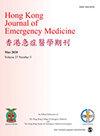急诊医生通过声门上气道装置进行光纤引导气管插管与超发声视频喉镜的比较:一项尸体随机对照研究
IF 0.8
4区 医学
Q4 EMERGENCY MEDICINE
引用次数: 1
摘要
背景:在气管插管失败、使用直接喉镜检查、使用声门上气道装置抢救后,尚未明确选择后续方法来固定最终气道。目的:本研究的目的是比较使用光纤气道镜引导气管插管通过声门上气道装置与使用超发声视频喉镜的更传统方法的插管时间。方法:采用单中心随机对照试验。研究对象是在成人创伤中心工作的急诊医生。干预措施是在光纤气道镜的引导下,通过声门上气道装置进行插管。比较是使用超发音视频喉镜进行插管。主要结果是插管时间。该试验在ANZCTR.org.au注册(ACTRN1262100018819)。结果:四名急诊医生在四具尸体上完成了两种气道装置的插管,共32个实验。插管的平均时间为14.0 s(95%置信区间 = 11.1–16.8),而非29.2 s(95%置信区间 = 20.7–37.7);相差15.2 s(95%置信区间 = 8.7–21.7,p < 0.001)。所有插管均在2 分钟,并且没有设备故障或气道损伤的证据。结论:无论是通过声门上气道装置进行光纤气道镜检查,还是通过高语言视频喉镜检查,急诊医生都可以在尸体上成功插管,而不会造成气道损伤。从统计数据来看,超角度视频喉镜比通过声门上气道设备的光纤气道镜快得多,但在临床上可以说并不显著。本文章由计算机程序翻译,如有差异,请以英文原文为准。
Comparison of fibre-optic-guided endotracheal intubation through a supraglottic airway device versus hyperangulated video laryngoscopy by emergency physicians: A randomised controlled study in cadavers
Background: After failed endotracheal intubation, using direct laryngoscopy, rescued using a supraglottic airway device, the choice of subsequent method to secure a definitive airway is not clearly determined. Objective: The aim of this study was to compare the time to intubation using a fibre-optic airway scope, to guide an endotracheal tube through the supraglottic airway device, with a more conventional approach using a hyperangulated video laryngoscope. Methods: A single-centre randomised controlled trial was undertaken. The population studied were emergency physicians working in an adult major trauma centre. The intervention was intubation through a supraglottic airway device guided by a fibre-optic airway scope. The comparison was intubation using a hyperangulated video laryngoscope. The primary outcome was time to intubation. The trial was registered with ANZCTR.org.au (ACTRN12621000018819). Results: Four emergency physicians completed intubations using both of the two airway devices on four cadavers for a total of 32 experiments. The mean time to intubation was 14.0 s (95% confidence interval = 11.1–16.8) in the hyperangulated video laryngoscope group compared with 29.2 s (95% confidence interval = 20.7–37.7) in the fibre-optic airway scope group; a difference of 15.2 s (95% confidence interval = 8.7–21.7, p < 0.001). All intubations were completed within 2 min, and there were no equipment failures or evidence of airway trauma. Conclusion: Successful intubation of the trachea without airway trauma by emergency physicians in cadavers is achievable by either fibre-optic airway scope via a supraglottic airway device or hyperangulated video laryngoscope. Hyperangulated video laryngoscope was statistically but arguably not clinically significantly faster than fibre-optic airway scope via supraglottic airway device.
求助全文
通过发布文献求助,成功后即可免费获取论文全文。
去求助
来源期刊

Hong Kong Journal of Emergency Medicine
EMERGENCY MEDICINE-
CiteScore
1.50
自引率
16.70%
发文量
26
审稿时长
6-12 weeks
期刊介绍:
The Hong Kong Journal of Emergency Medicine is a peer-reviewed, open access journal which focusses on all aspects of clinical practice and emergency medicine research in the hospital and pre-hospital setting.
 求助内容:
求助内容: 应助结果提醒方式:
应助结果提醒方式:


